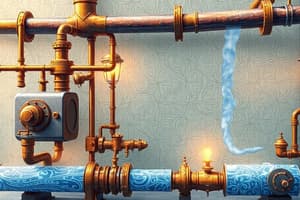Podcast
Questions and Answers
What is the primary function of the E-433 (Process Water Cooler)?
What is the primary function of the E-433 (Process Water Cooler)?
To cool untreated boiler feed water from Unit 1092 using cooling water.
How is positive pressure maintained in the E-480 (Common Ejector After Condenser) system?
How is positive pressure maintained in the E-480 (Common Ejector After Condenser) system?
Nitrogen is routed to the inlet line of E-480 to keep positive pressure.
Where are the condensate from various condensers routed after being collected?
Where are the condensate from various condensers routed after being collected?
They are routed to D-433 (Process Water Surge Drum).
What happens to the vent gas from D-433 and E-480?
What happens to the vent gas from D-433 and E-480?
What is the role of P-433A/B (Process Water Supply Pumps)?
What is the role of P-433A/B (Process Water Supply Pumps)?
What is the function of P-405A/B (C6-C10 Tower Bottom Pumps)?
What is the function of P-405A/B (C6-C10 Tower Bottom Pumps)?
Describe the purpose of E-413 (C6 Tower Preheater).
Describe the purpose of E-413 (C6 Tower Preheater).
What does D-410 (C6 Tower Reflux Drum) separate?
What does D-410 (C6 Tower Reflux Drum) separate?
What is the main goal of T-411 (Hexene Purification Column)?
What is the main goal of T-411 (Hexene Purification Column)?
How do P-406A/B (Hexene Reactor Charge Pumps) contribute to the hexene process?
How do P-406A/B (Hexene Reactor Charge Pumps) contribute to the hexene process?
What is the purpose of the D-401 (C6-C10 Tower Feed Coalescer)?
What is the purpose of the D-401 (C6-C10 Tower Feed Coalescer)?
What is the role of E-401 (C6-C10 Tower Feed Preheater)?
What is the role of E-401 (C6-C10 Tower Feed Preheater)?
What do the key process control objectives for T-400 (C6-C10 Tower) include?
What do the key process control objectives for T-400 (C6-C10 Tower) include?
What type of pumps are P-411A/B and what is their power rating?
What type of pumps are P-411A/B and what is their power rating?
How does E-400 (C6-C10 Tower Condenser) contribute to the operation of T-400?
How does E-400 (C6-C10 Tower Condenser) contribute to the operation of T-400?
What type of pumps are P-400A/B (C6-C10 Tower Reflux & Product Pumps), and what do they do?
What type of pumps are P-400A/B (C6-C10 Tower Reflux & Product Pumps), and what do they do?
What is the primary purpose of E-420 (C8 Tower Condenser)?
What is the primary purpose of E-420 (C8 Tower Condenser)?
What is the function of D-430 (C12-C24 Tower Reflux Drum)?
What is the function of D-430 (C12-C24 Tower Reflux Drum)?
How does E-425 (C8 Tower Reboiler) contribute to the C8 Tower's operation?
How does E-425 (C8 Tower Reboiler) contribute to the C8 Tower's operation?
What is the key control objective for T-420 regarding C10 and C8 concentrations?
What is the key control objective for T-420 regarding C10 and C8 concentrations?
What principle do ejectors operate on to lower pressure in the C12-C24 Tower?
What principle do ejectors operate on to lower pressure in the C12-C24 Tower?
What is the primary purpose of the E-435 (C12-C24 Tower Reboiler)?
What is the primary purpose of the E-435 (C12-C24 Tower Reboiler)?
Describe the role of the P-436A/B (Stripping Steam Condensate Pump).
Describe the role of the P-436A/B (Stripping Steam Condensate Pump).
What function do the F-443A/B (C12 Tower Feed Filters) serve in the process?
What function do the F-443A/B (C12 Tower Feed Filters) serve in the process?
How does the Z-435A/B (C30+ Centrifuges) contribute to product quality?
How does the Z-435A/B (C30+ Centrifuges) contribute to product quality?
Flashcards are hidden until you start studying
Study Notes
Process Water Surge Drum (D-433) Overview
- D-433 is used for maintaining the water level through untreated boiler feed water from Unit 1092.
- Untreated boiler feed water is cooled in E-433 (Process Water Cooler) using cooling water on the tube side.
Sources of Condensate
- Condensate from multiple sources including:
- Fractionation vent condensers.
- Ejector interstage condensers.
- Coalescers.
- Reflux drum boots.
- All condensate is routed to D-433.
Ejector After Condenser (E-480) Role
- Vents from ejectors are routed to the shell side of E-480 for cooling.
- Cooling water is utilized on the tube side of E-480.
- Nitrogen is supplied to the inlet line of E-480 to maintain positive pressure in the system.
Water Vapor Management
- Condensed water vapor from E-480 is directed to D-433.
- Vent gas from the tops of D-433 and E-480 is sent either to the 1st stage ejectors for spill back or to the Vent Header.
Process Water Supply System
- P-433A/B (Process Water Supply Pumps) transport process water to:
- P-340A/B (Caustic Wash Circulation Pumps).
- T-340 (Caustic Wash Vapor Scrubber).
- T-350 (Water Wash Vapor Scrubber).
C6-C10 Tower System Overview
- T-400 (C6-C10 Tower): 5’D x 72’3”L; separates C6-C10 light products from C12-C30 heavy products. Focuses on maintaining C12 concentration in the overhead and C10 concentration in the bottoms.
- D-401 (Coalescer): Removes water from the product stream; 2’D x 9’L with a containment boot.
- E-401 (Feed Preheater): Shell and tube exchanger that heats C6+ feed with 100 psig steam; not used if feed comes directly from T-380.
Vaporization and Condensation
- E-403 (Feed Vaporizer): Vaporizes C6+ feed using 400 psig steam; connected to T-400.
- E-400 (Condenser): Cools and condenses overhead vapor from T-400 using cooling water and provides reflux.
- D-400 (Reflux Drum): 4’D x 20’L; separates reflux liquid for T-400 and non-condensable vapor; collects water into D-430.
Pumping Systems
- P-400A/B (Reflux & Product Pumps): Single-stage centrifugal pumps using 20 HP motors to circulate reflux and route feed.
- E-405 (Reboiler): Kettle-type design; heats T-400 bottoms with Dowtherm.
- P-405A/B (Bottom Pumps): Routes liquid bottoms to T-430; also single-stage centrifugal pumps with 20 HP motors.
C6 Tower Operations
- T-410 (C6 Tower): 4’D x 52’3”L; extracts C6 fraction while controlling C8 and C6 concentrations.
- E-410 (Condenser): Cools overhead vapor with cooling water, providing reflux for T-410.
- D-410 (Reflux Drum): 4’D x 10’L; separates liquid for reflux and feed.
Hexene Processing
- T-411 (Hexene Purification Column): 8’D x 119’L; purifies hexene to ≥99.0% purity, removing contaminants.
- E-406 (Reactor Preheater): Heating hexene feed before R-411A/B reactors.
- R-411A/B (Hexene Reactors): Fixed bed up-flow reactors employing activated alumina to increase boiling points for distillation.
C8 and C12 Towers
- T-420 (C8 Tower): 3’6”D x 76’3”L; separates C8 and C10 while maintaining specifications for concentrations.
- T-430 (C12-C24 Tower): Separates C12-C20 from heavier fractions; focuses on controlling C24, C22, and other concentrations.
Reflux and Product Management
- D-430 (Reflux Drum): Manages reflux for T-430 and condenses non-condensable vapors.
- Z-430/Z-431 (Ejectors): First and second stages reduce pressure overhead for better separation.
- P-430A/B (Pumps): Circulate reflux to T-430 and route feed to T-440.
Final Product Collection
- Z-435A/B (C30+ Centrifuges): Separate heavy polymers from C30+ product using centrifugal force.
- P-833A/B (Clean Product Pumps): Route clean C30+ product to storage using 10 HP motors.
- D-431 (Accumulator): Collects C24-C28 product stream prior to storage.
Staging and Filtering
- F-443/F-430 (Feed Filters): Remove particulates before reaching respective towers.
- E-434 (Exchanger): Transfers heat efficiently between feeds and product streams across multiple processes.### C24-C28 Product Processing Equipment
- P-431A/B C24-C28 Product Pumps: Single stage centrifugal pumps with 25 HP, 3550 RPM electric motors, used for routing C24-C28 products to storage.
- E-432 C24-C28 Product Cooler: Shell and tube exchanger cooling C24-C28 products with untreated boiler feed water to prepare for storage.
- F-431 C24-C28 Product Filter: Cartridge filter removing molecular sieve fines from products before storage.
C12 Tower Process Equipment
- F-444 C12 Tower Feed Strainer: Removes particulate matter from the T-440 (C12 Tower) feed.
- E-443 C12 Tower Feed Preheater: Shell and tube exchanger heating C12 feed using 400 psig steam to improve efficiency in T-440.
- T-440 C12 Tower: Separates C12-C24 into overhead product and a C14-C24 blend for further processing in T-450.
- Objectives: Maintain specifications for C14 concentration in overhead and C12 in bottoms.
- E-440 C12 Tower Condenser: Cools and condenses overhead vapor from T-440, using boiler feed water for reflux or storage.
- D-440 C12 Tower Reflux Drum: Separates liquid for reflux and C12 product.
- E-441 C12 Tower Vent Condenser: Cools overhead vapor from D-440 for efficiency.
Ejectors and Pumps in C12 Operation
- Z-440 C12 Tower 1st Stage Ejector: Lowers pressure of T-440 overhead.
- E-449 Ejector Interstage Condenser: Cools steam from Z-440 condensate.
- Z-441 C12 Tower 2nd Stage Ejector: Further pressure reduction of T-440 overhead.
- P-440A/B C12 Reflux & Product Pumps: Circulate reflux to T-440 and route C12 product to storage, operated by 15 HP motors.
C14 Tower Processing
- F-453 C14 Tower Feed Strainer: Filters particulates from T-450 feed.
- T-450 C14 Tower: Separates C14-C24 into overhead product and a C16-C24 blend for T-460.
- Objectives: Control C16 concentration in overhead and C14 in bottoms.
- E-450 C14 Tower Condenser: Cools overhead vapors for reflux or for storage product.
- D-450 C14 Tower Reflux Drum: Manages reflux and C14 product.
- Z-450 C14 Tower 1st Stage Ejector: Initiates pressure reduction of T-450 overhead.
Ejector and Pump Functionality in C14 Process
- Z-451 C14 Tower 2nd Stage Ejector: Additional pressure lowering mechanism for T-450 overhead.
- P-450A/B C14 Reflux & Product Pumps: Deliver reflux to T-450 and send C14 to storage, utilizing 15 HP motors.
C16 Tower Operations
- F-463 C16 Tower Feed Strainer: Clears feed for T-460 of particulates.
- T-460 C16 Tower: Separates C16-C24 into an overhead product and a C18-C24 bottoms.
- Objectives: Regulate C18 in overhead and C16 in bottoms.
- E-460 C16 Tower Condenser: Cools overhead vapor using boiler feed water for reflux or storage.
- D-460 C16 Tower Reflux Drum: Divides reflux for T-460 from C16 product.
Ejector Functionality in C16 Processing
- Z-460/ Z-461 Ejectors: A two-stage system to progressively decrease pressure of T-460 overhead.
- P-460A/B C16 Reflux & Product Pumps: Manage reflux to T-460 and transport C16 product to designated tanks.
C18 Tower Process Overview
- F-473 C18 Tower Feed Strainer: Removes particulates from the T-470 feed.
- T-470 C18 Tower: Separates C18-C24 into overhead and bottoms, focusing on maintaining specifications for both products.
- E-470 C18 Tower Condenser: Cools overhead vapors for recycling as reflux or for product storage.
- D-470 C18 Tower Reflux Drum: Separates the liquid for reflux and C18 product.
Ejector and Pump Systems in C18 Process
- Z-470/Z-471 Ejectors: Staged ejectors to lower pressure of T-470 overhead, ensuring high efficiency.
- P-470A/B C18 Reflux & Product Pumps: Circulate reflux and send C18 product to storage or offspec locations.
Cooling and Product Treatment Systems
- E-476 C20-C24 Heat Recovery: Kettle-type heat exchanger transitioning liquid to vapor phase for cooling.
- E-477 C20-C24 Product Cooler: Shell and tube exchanger cooling products before storage.
Process Water System Components
- D-433 Process Water Surge Drum: Regulates constant feed of process water to the unit.
- E-433 Process Water Cooler: Cools untreated boiler feed water efficiently.
- E-480 Common Ejector Aftercondenser: Cools vents from ejectors, optimizing system performance.
- P-433A/B Process Water Supply Pumps: Route process water to various treatment and scrubber systems.
Studying That Suits You
Use AI to generate personalized quizzes and flashcards to suit your learning preferences.




